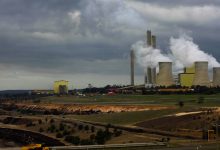Until last summer most Australians probably felt that air pollution was one problem we didn’t have. But by the first week of January, we were being warned to stay indoors to avoid the bushfire smoke.
That smoke was so bad that on some days, Melbourne’s air pollution was the worst in the world.
The smoke drifted away over time, but so too did our confidence that Australia’s air was always clean. And the reality is that, for much of Australia, the air hasn’t been clean for a long time.
And Victoria’s Andrews Government and their Environment Protection Authority (EPA) are failing to deal with a major source of the state’s air pollution – brown coal power stations.
Our air might look and smell clean, but it contains tiny soot particles that are about the size of bacteria. Measuring less than 2.5 microns and known as PM 2.5, these particles come out of car and truck exhausts and power stations, as well as bushfires, and they sneak into houses.
With the windows shut, indoor levels often match outdoor levels after an hour or two.
They are so small that they pass from our lungs into our blood where they can trigger strokes and heart disease. In 2010, air pollution was estimated to kill over 1.3 million people each year in China, and around 3,000 in Australia.
China’s government, concerned by the impact of this pollution, has set tight limits on how much particle pollution their power stations can release, while Victorian power stations continue to be allowed to release five to eight times more.
The stark difference between the tight Chinese emission limits and those in Victoria, applies to other pollutants as well. Victorian coal-burning power plants are allowed to release two to six times as much sulphur dioxide as those in China. Between them, Yallourn and Loy Yang A and B pump out so much sulphur dioxide that you can see it from space.
Sulphur dioxide causes coughing, wheezing, asthma and long-term lung disease. Sulphur dioxide from power stations slows the growth of the developing foetus, and is estimated to cause some cases of low birthweight seen in the Latrobe Valley.
But at least Victorian coal plants have a limit for sulphur dioxide.
For mercury, they have no limit at all. In contrast, strict limits apply to the amount of this accumulative nerve toxin that can be released by Chinese, European and US coal plants. It is highly toxic to the developing human brain in the foetus and in infancy, and can result in mental retardation if enough is consumed.
Each year, Victorian coal plants put over a tonne of mercury into the air, and this persists in the environment, accumulating in fish, and increasing in concentration as it goes up the food chain. As a result, dolphins in eastern Victoria have high levels of mercury and levels were three times higher in dead Burrunan dolphins found on beaches than in live dolphins.
Gippsland’s 270,000 residents, and few remaining dolphins, could be forgiven for thinking that the generous pollution limits applying to Victorian coal plants were chosen to suit the generators rather than the lungs of the locals.
A long-running review of the coal plant licences, underway since November 2017, could change all this.
More than three years later, this review seems to have stalled. Environment Minister Lily D’Ambrosio has so far been non-committal, although hinted that reform would come when I asked her about it in parliament both last year and the year before.
And while we wait, the growing popularity of solar panels is eating into the profits made by coal-fired power station owners. They’re unlikely to want to pay for costly new smokestack scrubbers and other technology needed to meet tighter standards. And they’re already hinting that having to compete with cheap sun and wind power might force them to close earlier than planned.
But another issue looms over the review of Victoria’s polluting coal plants, and that’s the massive carbon emissions from these big coal-burners as they consume a million tonnes of brown coal each week.
Victorian brown coal produces more carbon emissions per megawatt than the black coal used elsewhere in Australia. After our summer of climate-driven fires, we have to ask if there’s any point in making these monsters a little cleaner, when they’re cooking the planet?
The state government has to decide whether to let the Environment Protection Authority introduce standards that protect health and might close power stations, or whether to keep them open, despite the evidence that they’re not only bad for our climate, but damaging the health of those who live downwind.
So, don’t hold your breath waiting for clean air, but don’t breathe too deeply either.
Dr Tim Read is the Victorian Greens MP for Brunswick.










